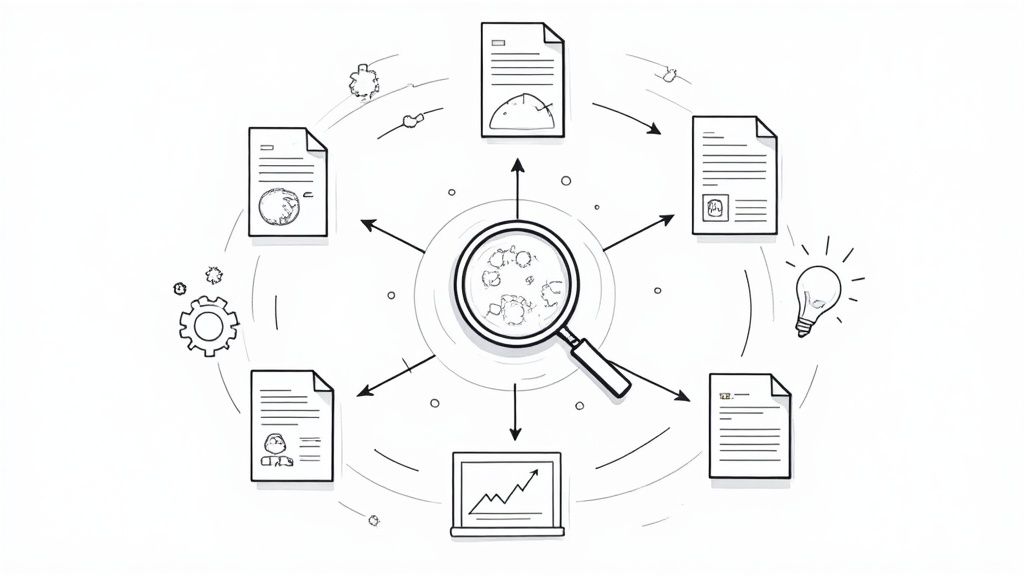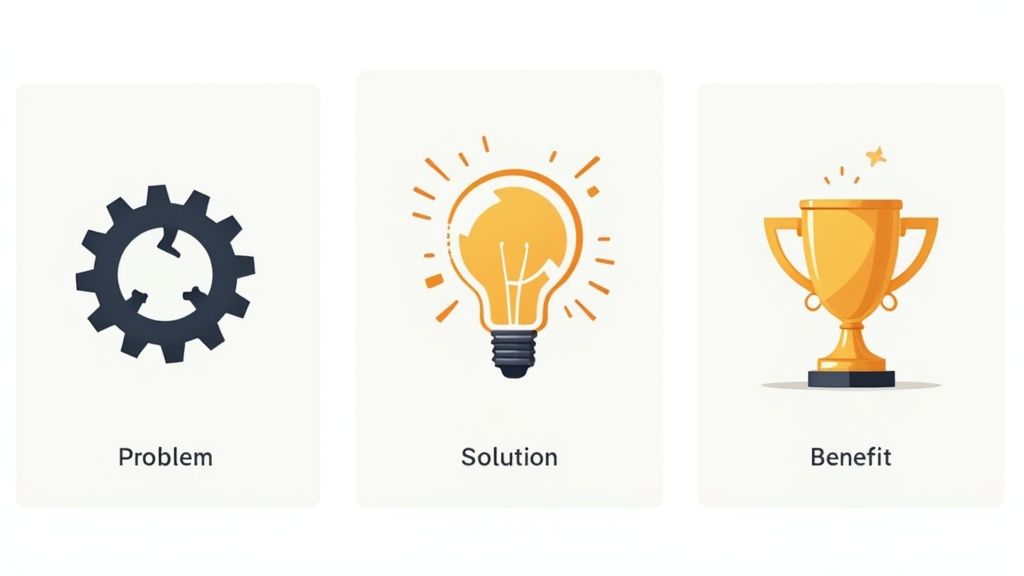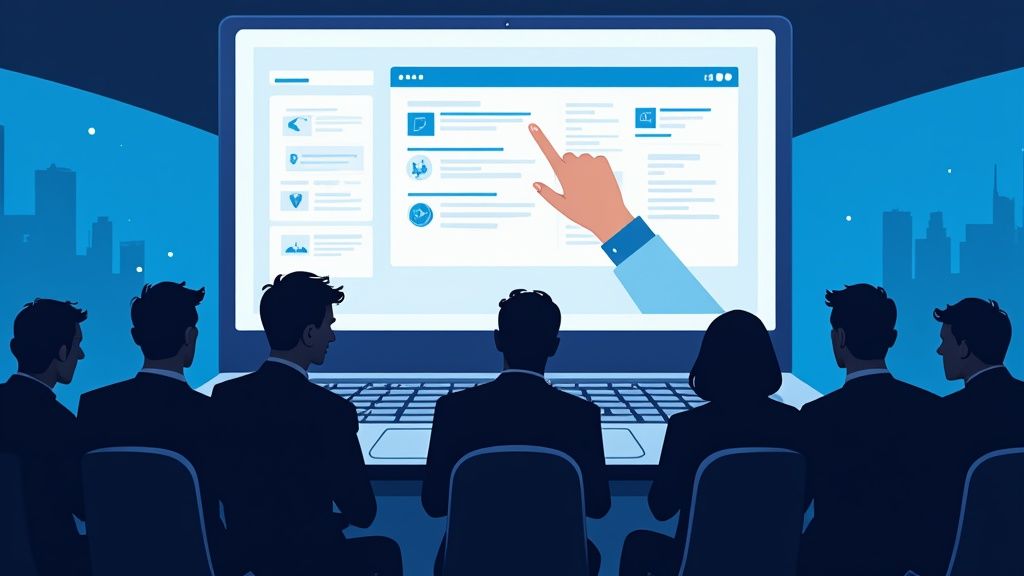6 Sales Presentation Examples PDF to Boost Your Pitch

Published : Jul 27, 2025
Written by: Madeson Sykes
17 minutes read
Transform Your Sales Pitch: Unleash the Power of Presentation Examples
Stop creating sales presentations from scratch. This listicle provides six downloadable sales presentation examples (PDF). Each example breaks down effective strategies and tactics you can use immediately. Learn how to structure a winning pitch and persuade your audience. We’ll analyze what makes these presentations successful, offering actionable takeaways you can implement in your own presentations. Whether you’re a seasoned sales professional or just starting out, these examples will help you close more deals.
Looking for a problem-solution approach? Need to showcase your ROI? We’ve got you covered. This listicle deconstructs a variety of approaches, including:
- The Problem-Solution-Benefit Framework
- The Story-Driven Presentation
- The Demo-First Presentation
- The Consultative Assessment Presentation
- The Competitive Differentiation Presentation
- The ROI-Focused Financial Presentation
Download these sales presentation examples PDF and revolutionize your sales process. Let’s dive in.
1. The Problem-Solution-Benefit Framework
The Problem-Solution-Benefit Framework is a time-tested sales presentation structure that resonates deeply with potential clients. It works by first identifying a specific problem the prospect faces. Then, it positions your product or service as the ideal solution. Finally, it clearly articulates the tangible benefits derived from adopting that solution. This logical flow keeps the presentation focused on the prospect’s needs.

This framework’s strength lies in its empathetic approach. By addressing pain points upfront, you immediately establish relevance and capture attention. This makes the transition to presenting your offering as the answer much smoother and more persuasive. Think of it like a doctor diagnosing a patient before prescribing medicine.
Examples in Action
Consider Salesforce. Their CRM presentations effectively target the problem of data silos within large enterprises. They showcase how their platform consolidates information, leading to improved efficiency and collaboration. Similarly, Zoom’s early presentations highlighted the challenges of remote collaboration before demonstrating how their platform provided a seamless solution.
HubSpot also uses this framework brilliantly. Their inbound marketing presentations often begin by addressing the common problem of lead generation. Then, they illustrate how their software helps businesses attract and convert leads organically. These examples show how establishing the problem first sets the stage for a compelling solution.
Actionable Tips for Implementation
- Research: Deeply research industry-specific challenges before your presentation. Demonstrate your understanding of the prospect’s unique context.
- Data-Driven Approach: Use the prospect’s own data, if possible, to illustrate the problem’s impact. This adds weight and credibility to your presentation.
- Quantifiable Benefits: Don’t just talk about benefits - quantify them. Express them in terms of time saved, revenue increased, or costs reduced.
- Case Studies: Include two to three relevant case studies featuring similar companies who successfully overcame the same problem using your solution.
- Clear Call to Action: Always end with a clear next step or call to action. This could be scheduling a demo, starting a trial, or requesting a proposal.
When and Why to Use This Framework
The Problem-Solution-Benefit Framework is highly effective for sales presentation examples pdf and is particularly useful when dealing with complex products or services. It’s perfect for situations where the value proposition isn’t immediately obvious. By clearly defining the problem and showcasing your offering as the solution, you guide the prospect through a logical journey towards recognizing the value you provide.
This framework’s widespread adoption by figures like Dale Carnegie and its integration into methodologies like Neil Rackham’s SPIN Selling underscores its enduring effectiveness. Traditional enterprise software companies have long leveraged its power, proving its applicability across diverse industries. It deserves a place in every salesperson’s toolkit due to its inherent ability to connect with prospects on a fundamental level by addressing their needs first.
2. The Story-Driven Presentation
The Story-Driven Presentation moves away from dry facts and figures. It leverages the power of narrative to connect with audiences on an emotional level. This approach transforms product features into compelling stories. These narratives showcase customer success, challenges overcome, and transformations achieved. This makes complex information more memorable and relatable.

Storytelling taps into our innate human desire to connect with narratives. By framing your presentation as a story, you capture attention and foster deeper engagement. This emotional connection increases the likelihood of your message resonating with the prospect. It also makes your presentation more persuasive.
Examples in Action
Airbnb’s expansion presentations often feature success stories of individual hosts. These stories highlight how Airbnb empowered them to achieve financial independence or pursue their passions. Tesla uses customer journey narratives in dealership presentations. They demonstrate the seamless transition to electric vehicle ownership and the lifestyle benefits associated with their brand. Slack showcases team transformation stories for enterprise clients, illustrating improved communication and productivity gains.
Actionable Tips for Implementation
- Real Customer Stories: Use authentic customer stories with their permission. This adds credibility and emotional impact.
- Specific Details and Metrics: Include concrete details and quantifiable metrics within your stories. This reinforces the tangible benefits of your offering.
- Practice Delivery and Timing: Rehearse your storytelling delivery to ensure a natural and engaging flow. Pay attention to pacing and timing for maximum impact.
- Connect to Prospect’s Situation: Tailor your stories to resonate with the prospect’s specific challenges and aspirations. This demonstrates relevance and understanding.
- Visual Aids: Use visual aids like images or short videos to enhance the narrative and create a more immersive experience.
When and Why to Use This Framework
The Story-Driven Presentation is highly effective for sales presentation examples pdf and is particularly valuable when selling products or services with intangible benefits or complex value propositions. It’s ideal for emotionally driven purchases and for building rapport with prospects.
This approach is becoming increasingly popular, particularly in the SaaS industry. Companies like Slack and Airbnb have demonstrated its effectiveness in driving customer acquisition and engagement. The influence of figures like Steve Jobs and Andy Raskin further validates the power of storytelling in sales presentations. This method deserves a prominent place in any salesperson’s toolkit for its ability to forge genuine connections and drive persuasive communication.
3. The Demo-First Presentation
The Demo-First Presentation flips the traditional sales script. Instead of leading with slides and explanations, it prioritizes showing the product in action. This hands-on approach allows prospects to immediately grasp the value proposition by experiencing the solution firsthand. This method is particularly effective for software and technology products where functionality is key. It allows potential customers to visualize how the product solves their problems before delving into the technical details.

This approach’s strength lies in its ability to quickly capture attention and generate excitement. Seeing the product in action creates a more engaging and memorable experience than passively listening to a presentation. This immersive experience can significantly shorten the sales cycle by quickly demonstrating value and addressing potential objections upfront.
Examples in Action
Consider Notion. Their workspace setup demonstrations showcase the platform’s flexibility and customization options. Figma’s collaborative design sessions allow potential users to witness the power of real-time co-creation. Loom’s screen recording walkthroughs effectively demonstrate the ease and efficiency of video communication. These examples demonstrate how a captivating demo can speak volumes.
Actionable Tips for Implementation
- Backup Plans: Always have backup plans for technical failures. A seamless backup ensures a professional image, even with unexpected glitches.
- Prospect’s Data: Use the prospect’s actual data when possible. This personalization instantly connects the demo to their specific needs.
- Key Use Cases: Keep demos focused on key use cases. Avoid overwhelming the prospect with unnecessary features.
- Smooth Transitions: Practice transitions between the demo and discussion. Maintaining a natural flow keeps the audience engaged.
- Q&A Preparation: Prepare for common questions and objections. Anticipating potential concerns ensures a confident and informative response.
When and Why to Use This Framework
The Demo-First Presentation is an excellent choice for sales presentation examples pdf, especially when dealing with visual or interactive products. It’s a powerful approach when the product’s functionality is its primary selling point. This method allows prospects to experience the value proposition directly, leading to faster buy-in.
This framework’s rising popularity within product-led growth methodologies and its adoption by successful SaaS companies like Atlassian and Zendesk underscore its effectiveness. It’s a valuable tool for modern sales development teams seeking to engage prospects in a more dynamic and impactful way. Its ability to showcase value quickly and transparently makes it a valuable addition to any sales strategy.
4. The Consultative Assessment Presentation
The Consultative Assessment Presentation flips the traditional sales script. Instead of leading with a product pitch, it positions the salesperson as a consultant. This approach uses the presentation as a tool to uncover the prospect’s needs, assess their current situation, and collaboratively develop solutions. This emphasizes discovery and two-way dialogue over a one-sided product demonstration.
The bar chart above visualizes the impact a consultative approach can have on key sales metrics. As shown, this approach can uncover hidden needs, improve win rates, and shorten the sales cycle.
Examples in Action
Management consulting firms like McKinsey excel at this. Their diagnostic presentations for organizational change delve deep into a company’s structure and processes, identifying areas for improvement before proposing tailored solutions. Similarly, IBM uses business transformation assessments to understand a client’s technological landscape and recommend strategic upgrades. PwC’s technology readiness evaluations provide another example, assessing a company’s preparedness for digital transformation.
Actionable Tips for Implementation
- Prepare Diagnostic Frameworks: Develop industry-specific frameworks to guide your assessment and ensure you cover key areas.
- Benchmarking Data: Bring relevant benchmarking data to compare the prospect’s performance against industry averages. This provides valuable context and highlights potential gaps.
- Visual Tools: Utilize visual tools like maturity models to illustrate current state and desired future state, facilitating a shared understanding.
- Document Findings: Thoroughly document your findings and recommendations in a clear and concise manner. This reinforces your expertise and provides a valuable takeaway for the prospect.
- Follow-Up Reports: Send detailed assessment reports after the presentation, summarizing the key findings and proposed next steps.
When and Why to Use This Framework
The Consultative Assessment Presentation is highly effective for sales presentation examples pdf, particularly for complex sales involving high-value solutions. It’s ideal when the prospect’s needs are not fully understood or when the solution requires significant customization. This method builds trust and credibility by demonstrating genuine interest in the prospect’s challenges and positioning you as a valuable partner.
This framework’s strength lies in its collaborative nature. By engaging the prospect in a two-way dialogue, you gain a deeper understanding of their specific needs and pain points. This enables you to tailor your solutions more effectively, leading to increased win rates and stronger client relationships. The consultative approach fosters trust and differentiates you from competitors who rely on traditional, product-centric presentations. It’s particularly valuable in scenarios where the buyer journey is complex and involves multiple stakeholders.
5. The Competitive Differentiation Presentation
The Competitive Differentiation Presentation focuses on directly addressing competitive alternatives and highlighting why your solution stands out. This approach acknowledges the existing competitive landscape while showcasing your product or service’s unique value propositions and competitive advantages. It’s a powerful way to position yourself as the superior choice.
This presentation style works by first acknowledging the options available to the prospect. It then systematically demonstrates how your offering surpasses the competition in key areas relevant to the prospect’s needs. This head-to-head comparison allows you to directly address potential objections and solidify your value.
Examples in Action
Consider the ongoing battle between project management software giants like Monday.com and Asana. Their presentations often involve competitive comparisons, focusing on specific features, pricing models, and user interface advantages. Similarly, in the CRM space, Salesforce and Microsoft Dynamics frequently engage in comparative presentations. They showcase their strengths in areas like customization, integration, and scalability. Cloud infrastructure providers like AWS and Azure also leverage this approach, comparing their services based on performance, security, and cost-effectiveness.
These examples highlight how focusing on specific differentiators helps prospects make informed decisions based on their unique requirements.
Actionable Tips for Implementation
- Focus on Capabilities: Concentrate on showcasing what your product can do, rather than criticizing what competitors can’t. This positive approach builds trust and credibility.
- Third-Party Validation: Leverage data from reputable third-party sources to support your competitive claims. This adds objectivity and strengthens your argument.
- Highlight Unique Differentiators: Clearly and prominently display the features or benefits that set you apart. Focus on what truly makes you unique.
- Customer Testimonials: Include testimonials from customers who switched from a competitor to your solution. Their experiences provide powerful social proof.
- Current and Accurate: Ensure your competitive information is up-to-date and accurate. Outdated data can damage your credibility.
When and Why to Use This Framework
The Competitive Differentiation Presentation is exceptionally useful in crowded markets where prospects are evaluating multiple options. This approach shines when selling sales presentation examples pdf in competitive landscapes like software, technology, or B2B services. It’s ideal when your product or service offers a discernible advantage over the competition.
This framework is highly effective because it directly addresses the prospect’s need to make an informed choice. It provides a clear comparison, simplifies decision-making, and demonstrates the superior value of your offering. By confidently addressing the competition head-on, you position yourself as a market leader and increase the likelihood of closing the deal. This approach, often employed by industry giants like Microsoft and Oracle, has become a staple for B2B software companies navigating competitive markets. Its strategic focus on differentiators makes it an essential tool for any sales professional aiming to stand out from the crowd.
6. The ROI-Focused Financial Presentation
The ROI-Focused Financial Presentation speaks directly to the bottom line. It zeroes in on the financial implications of adopting your product or service, emphasizing return on investment (ROI) calculations, cost savings, and overall economic impact. This approach resonates strongly with financially-minded decision-makers who prioritize tangible business outcomes and quantifiable results. It’s about demonstrating value through numbers.
This framework’s effectiveness stems from its clear and objective nature. By focusing on financial metrics, you remove ambiguity and provide concrete evidence of the value your offering brings. This data-driven approach builds trust and credibility, making it easier for decision-makers to justify the purchase.
Examples in Action
Enterprise software vendors often excel at this. For example, presentations for ERP system implementations typically include detailed multi-year ROI models projecting cost savings and efficiency gains. Similarly, manufacturing automation companies showcase productivity improvements and reduced labor costs through quantifiable data. Energy efficiency solutions providers also employ this tactic by highlighting utility savings and reduced environmental impact. These examples underscore the power of hard numbers in driving purchasing decisions.
Actionable Tips for Implementation
- Conservative Estimates: Use conservative estimates for your projections to maintain credibility and avoid overpromising.
- Comprehensive Cost Savings: Include both hard cost savings (e.g., reduced material costs) and soft cost savings (e.g., increased productivity). This provides a more complete picture of the financial benefits.
- Sensitivity Analysis: Provide sensitivity analysis for key variables to demonstrate how changes in assumptions might impact the ROI. This shows you’ve considered various scenarios.
- Customer Data: Source data from similar customer implementations or case studies to support your projections. This adds real-world validation to your claims.
- One-Page Summary: Create a simple one-page ROI summary for easy reference and sharing. This allows decision-makers to quickly grasp the key financial takeaways.
When and Why to Use This Framework
The ROI-Focused Financial Presentation is exceptionally useful for sales presentation examples pdf when dealing with financially-driven buyers, especially in B2B contexts. It’s particularly effective for high-value products or services where the financial implications are a primary concern.
This approach has been popularized by enterprise software vendors, management consulting firms, and industrial and manufacturing companies. Its widespread use in these sectors demonstrates its effectiveness in communicating value to decision-makers who prioritize financial returns. This framework deserves a place in any salesperson’s toolkit when dealing with budget-conscious buyers. It offers a compelling and persuasive way to demonstrate the financial advantages of your offering.
6 Sales Presentation Styles Comparison
| Presentation Type | Implementation Complexity 🔄 | Resource Requirements 🔄 | Expected Outcomes 📊 | Ideal Use Cases 💡 | Key Advantages ⭐ |
|---|---|---|---|---|---|
| The Problem-Solution-Benefit Framework | Moderate: Requires research and customization | Medium: Data, visuals, testimonials needed | Clear ROI focus; emotional connection | Addressing urgent pain points; traditional sales | Logical flow; broadly applicable; easy customization |
| The Story-Driven Presentation | High: Needs strong storytelling skills | High: Narrative development, multimedia | High engagement and memorability | Complex concepts; emotional engagement; SaaS | Builds trust; differentiates; memorable |
| The Demo-First Presentation | High: Live demo setup with technical risk | High: Product expertise, demo setup | Immediate proof of value; interactive interest | Software/tech products requiring hands-on experience | Showcases value instantly; interactive; proof-based |
| The Consultative Assessment Presentation | High: Intensive prep, expert knowledge required | High: Diagnostic tools, assessments | Trust-building; uncover hidden needs | Complex B2B sales; consulting; custom solutions | Builds credibility; uncovers hidden opportunities |
| The Competitive Differentiation Presentation | Medium-High: Requires deep competitive insights | Medium: Competitive data, validation sources | Clear differentiation; reduces objections | Crowded markets with strong competitors | Proactively addresses competitors; builds confidence |
| The ROI-Focused Financial Presentation | Medium: Financial modeling and data accuracy | Medium: Detailed ROI models and financial data | Quantifiable justification; budget approval | Financial decision makers; cost-sensitive buyers | Speaks to finance; creates urgency; facilitates buy-in |
Boost Your Sales Presentations with Href.sh
Throughout this article, we’ve explored six powerful sales presentation frameworks, providing you with downloadable sales presentation examples PDF to guide your own approach. We delved into the core strategies behind each example, highlighting key takeaways and actionable insights you can implement immediately. From the problem-solution-benefit framework to the ROI-focused financial presentation, you’ve now got a diverse toolkit to tackle various sales scenarios.
Key Takeaways and Actionable Insights
Let’s recap the most crucial elements for creating compelling sales presentations:
- Understand your Audience: Tailor your message to resonate with their specific needs and pain points. This resonates throughout all the sales presentation examples PDF we’ve covered.
- Focus on Value: Clearly articulate the benefits your product or service offers and how it solves a problem. This is especially critical for the problem-solution-benefit and ROI-focused presentations.
- Tell a Story: Connect with your audience on an emotional level by weaving a compelling narrative around your product. The story-driven presentation example showcases this perfectly.
- Show, Don’t Just Tell: Demonstrations, visuals, and data can significantly enhance your message’s impact, as seen in the demo-first approach.
- Build Trust and Credibility: Position yourself as a consultant and advisor, as highlighted in the consultative assessment presentation. This fosters stronger relationships with potential clients.
- Differentiate Yourself: In competitive landscapes, showcasing what makes you unique is vital. The competitive differentiation presentation example offers practical strategies for achieving this.
Mastering Sales Presentation Strategies
By mastering these core concepts, you can elevate your sales game, build stronger client relationships, and ultimately close more deals. These principles apply whether you’re using a simple pitch deck or a complex, data-driven presentation. Remember, the key is to connect with your audience authentically and demonstrate the value you bring to the table.
Streamline Your Sharing Process
Now that you’re equipped with winning strategies and downloadable sales presentation examples PDF, streamline your sharing process with Href.sh. Host your PDFs, landing pages, and entire sales presentations in seconds with Href.sh - a fast and free way to share your work online. Generate trackable links, custom domains, and even password-protect your sales materials with ease. Focus on what matters most: closing the deal. Ready to simplify your workflow and share your polished sales presentations seamlessly? Get started with Href.sh today and experience the easiest way to share your sales presentation examples PDF online.